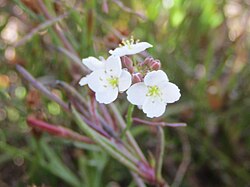Biology:Heliophila pusilla
| Heliophila pusilla | |
|---|---|

| |
| Scientific classification | |
| Kingdom: | Plantae |
| Clade: | Tracheophytes |
| Clade: | Angiosperms |
| Clade: | Eudicots |
| Clade: | Rosids |
| Order: | Brassicales |
| Family: | Brassicaceae |
| Genus: | Heliophila |
| Species: | H. pusilla
|
| Binomial name | |
| Heliophila pusilla L.f.
| |
| Synonyms[1] | |
|
Ormiscus pusillus (L.f.) Eckl. & Zeyh. (1835) | |
Heliophila pusilla, the dainty sunspurge, is a species of plant in family Brassicaceae. It is endemic to the Cape Provinces of South Africa .[1]
Description
This slender annual grows up to 30 cm (12 in) tall.[2] The hairless stems are be soft and wiry or flaccid.[3] The leaves are thread-like or lance shaped, with the widest portion near the tip.[2] They are 5–35 mm (0.20–1.38 in) long and 3–15 mm (0.12–0.59 in) wide.[3]
Flowers are present between August and October, forming dense racemes.[2][3] They range from white to mauve in colour.[2] The petals, which range from 2 to 6 mm (0.079 to 0.236 in) in length, sometimes have basal appendages.[3] They have 3-12 ovules.
The fruits have a submoniliform shape and are 5–18 mm (0.20–0.71 in) long.[2] The bead-like structures are either continuous or joined by narrow waists.[3]
Subspecies and varieties
Four subspecies and varieties are accepted:[1]
- Heliophila pusilla var. lanceolata (Adamson) Marais
- Heliophila pusilla subsp. macrosperma (Marais) Al-Shehbaz
- Heliophila pusilla subsp. pusilla
- Heliophila pusilla var. setacea (Schltr.) Marais
Distribution and habitat
The dainty sunspurge is found growing between the Kouebokkeveld Mountains and De hoop in South Africa .[2] It has also been introduced in Australia .[4] It prefers clay soils.[2]
Conservation
Although the species as a whole is considered to be of least concern, Heliophila pusilla var. lanceolata is considered to be rare.[5][6] It is found in damp, sheltered areas on south- and west-facing slopes on Karbonkelberg, Chapman's Peak, and the Noordhoek Mountains.
References
- ↑ 1.0 1.1 1.2 Heliophila pusilla L.f. Plants of the World Online. Retrieved 7 October 2023.
- ↑ 2.0 2.1 2.2 2.3 2.4 2.5 2.6 Manning, John; Goldblatt, Peter (2012). Plants of the Greater Cape Floristic Region : 1: the core Cape flora. Pretoria: South African National Biodiversity Institute, SANBI. ISBN 978-1-919976-74-7. OCLC 852384288. https://www.sanbi.org/sites/default/files/documents/documents/strelitzia-29-2012.pdf.
- ↑ 3.0 3.1 3.2 3.3 3.4 e-Flora of South Africa. v1.36. 2022. South African National Biodiversity Institute. http://ipt.sanbi.org.za/iptsanbi/resource?r=flora_descriptions&v=1.36
- ↑ Shaw, Elizabeth A. (1974). "Revisions of Some Genera of Cruciferae Native to Australia". Contributions from the Gray Herbarium of Harvard University (205): 147–162. ISSN 0195-6094. https://www.jstor.org/stable/41764715.
- ↑ Foden, W.; Potter, L. (2005). "Heliophila pusilla L.f. var. pusilla. National Assessment: Red List of South African Plants version 2020.1.". http://redlist.sanbi.org/species.php?species=2878-147.
- ↑ von Staden, L. (2016). "Heliophila pusilla L.f. var. lanceolata (Adamson) Marais. National Assessment: Red List of South African Plants version 2020.1". http://redlist.sanbi.org/species.php?species=2878-145.
Wikidata ☰ Q17246434 entry
 |

